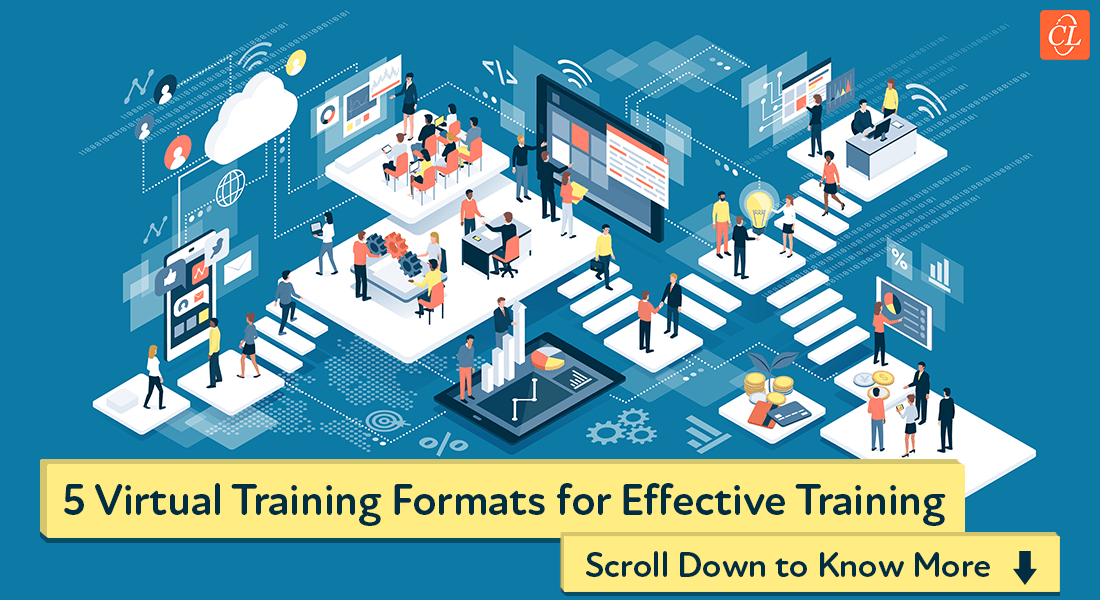Virtual Training: Why it’s Surpassing Traditional Learning?
Virtual training and eLearning have expanded horizons for the business and training worlds. Greater resources, flexibility, and accessibility are a few manifold advantages of online learning. Read on to explore the benefits.

Recent technological advancements have transformed every aspect of the global lifestyle, and corporate training is no exception. eLearning has had a major impact on the skill-building environment, with trainees and instructors alike benefitting from virtual training.
In 2025, we expect the global eLearning market to be worth $325 billion. This includes everything from employee training to learning for personal gain. According to a study of 2,500 companies, those businesses with extensive hybrid training programs earn two times more for each employee and raise their profit margins by 24%. With this, it’s noteworthy that IBM saved almost $200 million by making the shift to eLearning.
So, is virtual learning the future of training? Scroll down to find out.
Bid Farewell to Traditional Learning, and Say Hello to the Future of Corporate Training, That Is, Online Learning
Here’s why online learning is the future of training:
- It’s more flexible and it’s learner-centric
- Trainees can access it anytime, anywhere
- The capacity of learning skyrockets
- Online forums encourage discussions and engagement
- It caters to individual learning patterns and schedules
- It makes skill-building even more accessible and cost-effective
The Shortcomings of Traditional Learning
Traditional learning takes us back to a time when conventional classroom methods ruled the corporate training space. It was the most common and trusted mode of training before the rise of virtual learning. However, the shortcomings of traditional learning are clearer now more than ever.
Here’s a glance at the disadvantages of traditional learning:
Long, Tiresome Hours
Traditional learning can be exhausting for both instructors and trainees, specifically when training takes place before or after regular working hours. It also comes with the need to absorb information where employees are stuck in one place for long time periods. This can get tiresome, and it creates a lack of focus and motivation which are keys to learning well.
Difficult Time Management
Traditional learning runs on fixed times with reduced flexibility. The business world is always shifting, and time management can become challenging when there are drastic changes in sessions and schedules. Traditional training is not accessible outside the four walls of a classroom. This is not an ideal situation for someone who is juggling several responsibilities, whether they’re a trainee or an instructor.
Resource-intensive
Traditional learning methods warrant a considerable number of resources. From printing and supply costs to employee schedules and trainer expenses, classroom instruction can rely heavily on your budget.
Obstacles to Retention
Traditional training has the disadvantage of emphasizing standard methods and results of training. Employees could face issues remembering critical and nuanced lectures in instructor-led training and learners might then disengage. According to the SHRM, job-related development opportunities influence the decisions employees make on whether they stay in their present roles. Traditional training strategies and challenges have been known to jeopardize employee retention.
Getting started with virtual training? Here’s what you need to know!
Why Virtual Training is Better
As we begin our journey, learning more about virtual training, perhaps a good place to start is to define it. Virtual Training is a highly engaging, instructor-led training strategy with clearly defined learning goals enabling learners to connect on web-based platforms. These platforms comprise a set of technologies that allow learners and trainers to engage and collaborate through chat boxes, whiteboards, breakout rooms, and screen-sharing.
VILT sessions range from 60 to 180 minutes. Blended learning programs are integrated plans including in person training and online learning, including eLearning and webinars.
The benefits of virtual training are multi-faceted. It reduces costs while delivering training in an engaging manner. You can tailor virtual platforms to fit specific needs of employees. The case in favor of virtual learning is strong and blatantly evident.
1. Flexibility
According to studies conducted by Finances Online, employees today seek workplace solutions that accommodate their lifestyles. Employees can access training at their’ convenience to satisfy their need for flexibility and boost their morale. Also, almost 60% of employees want to engage in self-directed learning.
Virtual learning is flexible. New hires can access training at their leisure. In addition, unlike regular corporate training courses, employees undertaking training can adjust their pace of learning. This allows them even more control of their calendars and it offers them the freedom to adapt to their company’s culture and their role.
2. Accessibility
Virtual learning is a cornucopia of accessible resources. It provides trainees and instructors with material they wouldn’t have access to through conventional classroom learning, regardless of their position or location.
One of the major advantages of virtual training is the global and remote workforce can access it 24 hours a day, seven days a week. As per the report by Finances Online, over 60% of employees prefer learning on the go through online learning modules.
Does your training involve a significant number of materials that employees can access later? Virtual training gives them the opportunity to engage with resources at the point of their need. Microlearning, including infographics and quick videos, and mobile learning are a few efficient catalysts of just-in-time learning. Instead of confining your learners to the classroom, eLearning resources can let them work and train on the go!
Authoring tools assist you in creating relevant and fascinating material for online learners. The right tools are easy to use and aid in the development of responsive courses that you can access at any time, and from any location. They also come with built-in assets that help you enhance your courses and fulfill your bottom line. Authoring tools can help you streamline your training and reducing your workload.
3. Vast Study Scope
There are a limitless number of skills and topics to train and learn in an environment as broad and diverse as the internet. A rising number of businesses are providing online learning platforms for different levels of corporate experience.
Once you’ve developed your virtual training modules, it’s possible to scale them to reach as many employees as you want. You can also leverage the power of eLearning translation to convert them into as many languages as you need. This is a practical benefit for today’s global workforce.
With gamification, multimedia, and other interactive materials, eLearning can significantly improve employee engagement and recall of critical information. It’s specifically relevant to highly specialized topics , such as software training, compliance processes, and reference guides and to employees who are on the go.
4. Discussion Forums
It’s a common myth that online courses don’t provide many opportunities for social engagement as classroom training courses do. Learners can connect with each other and the instructor through online discussion forums, applications, and various social media platforms.
Discussion forums give employees the opportunity to hear from peers around the world. Is there a better way to absorb and assimilate best practices and share global experiences? A classroom setting, on the other hand, promotes in person communication in small groups. Virtual training modules facilitate inter-department and global collaboration from the get-go.
5. Customized Learning
One-on-one engagement between trainees and instructors is possible on online learning platforms. With virtual training, instructors can use multimedia formats for employees to gain even more dynamic and personalized learning experiences.
Virtual training allows you to curate sessions and modules that cater to learning patterns that are unique to your employees. It offers a highly customizable learning landscape.
Throughout an online course, employees have access to real-time feedback. As the world is interconnected on the web, senior management can immediately receive updates and data about the completion of courses and the progress of individual learners.
You can accomplish your L&D goals effectively if you have pertinent information on your trainees. Executives can achieve a deeper understanding of what’s working and what isn’t through learning data. Also, LMS analytics can identify trends and enable your data-driven decisions to strengthen your training strategy. This way, you can provide exceptional learning experiences.
6. Cost-Effective
eLearning, in a nutshell, is more cost-effective for today’s global workforce. Virtual training helps decrease logistical expenses associated with trainers, employees, training rooms, travel, food, and supplies. Trainees only need access to a smartphone or a computer and the time to complete their training.
According to Training Magazine, you can save 80% of total expenses on printing costs alone. Virtual training has helped businesses save thousands of dollars. These savings are the tangible benefits of eLearning. To sum up, the financial commitment is low, and the outcomes are high compared to traditional training strategies.
It’s a Wrap!
These are the reasons to choose online training over conventional learning. And they answer questions of trainees preferring online learning and corporations witnessing increased income after introducing this innovative approach to workplace training.
Your company must assess its unique requirements and design sessions based on their training needs and business goals. Virtual learning may not be the best avenue for everyone but remember, the possibilities are endless!
Do you want to integrate online learning into your corporate training approach? This webinar recording can help you pave a path for your business and help you revolutionize your training programs!





